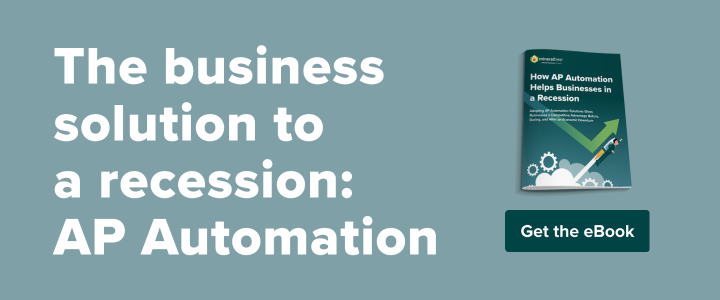Today’s business landscape has economists on their toes: the lingering impacts of COVID-19 along with supply chain disruptions has restricted economic output and driven up costs. These higher costs have led to widespread inflation and prompted the Fed to hike up interest rates, thereby driving up the cost of capital for businesses and borrowing costs for consumers. These higher borrowing costs should eventually decrease demand for goods and services from both businesses and their consumers until prices can drop to pre-inflation levels. Unfortunately, inflation doesn’t exist in a vacuum. Russia’s invasion of Ukraine and subsequent sanctions have added more nuance and unpredictability to today’s global economy, making it much harder to predict what the next three, six, or even twelve months will bring.
Recession is a common concern when prices inflate too quickly. And since earlier this summer we saw the largest consumer price inflation in over 40 years, many experts today predict a recession may soon (or already) be upon us. In the United States, experts commonly define a recession as two or more consecutive quarters of declining GDP. Others define a recession as a decline in economic activity spread across the global economy lasting more than a few months.
Business Impacts During a Recession
As mentioned above, the Fed normally responds to inflation by raising interest rates. This ultimately creates more constraints on capital spending for businesses by driving up costs and shrinking margins. As borrowing rates go up, overall demand amongst customers declines. With less demand and predictability, many businesses prefer to keep cash on hand during a recession by delaying invoice payments. As a result, this puts additional pressure on cash flow and inventory costs for suppliers.
3 Key Priorities for AP Teams During a Recession
AP teams inherently feel these impacts during economic downturns. Here are three focus areas AP departments should prioritize during a recession.
1. Efficiency
AP teams must maintain their normal level of output with fewer resources during recessions. Without the ability to add headcount or new spend on business process outsourcing, lean AP teams must optimize their workflow wherever possible. Tracking AP metrics is one way that teams can identify areas to optimize their processes and then track their improvements over time.
2. Vendor Relationships
Global supply chain disruptions have made supplier relationships a top priority for AP teams this year. In fact, 71% of organizations in 2022 reported that their supplier relationships have grown more important to their business over the last year. With fewer suppliers able to reliably source necessary goods, maintaining healthy supplier relationships have an added urgency for businesses. In order to appease strategic vendors, firms should make sure to make timely payments and answer vendor inquiries promptly.
3. Visibility
When it comes to recessions, business stakeholders need clear visibility into cash flow and working capital to navigate critical business decisions when facing cash crunch. An organized, digital AP process is the key to providing reliable, timely visibility to both the AP team and business leaders.
How Your AP Team Can Help Fight Recession
If your AP team isn’t sure how to prepare for a recession, these are a few places you can start.
1. Focus on what AP can control and contribute.
Look for opportunities to cut costs by optimizing processes, eliminating inefficiencies and analyzing spend data. These are lessons that you most likely learned during the pandemic, but they still apply to a broader recession.
2. Establish accurate cash forecasting methods.
Cash forecasting is especially important during a recession, as business leaders strategize where to cut back spending. In order to make a clear, organized plan for the business, executive teams must anticipate company spending which requires a cash forecasting model. AP automation tools along with an organized ERP system are key to establishing the necessary visibility for cash forecasting.
3. Communicate proactively with suppliers.
Don’t forget that recessions affect your vendors too. During times of uncertainty, communication is invaluable. Make sure to answer vendor inquiries and optimize your payment timings to alleviate cash flow concerns for both parties.
The Best Accounts Payable Tools for a Recession
When it comes to a recession, most teams are (understandably) hesitant to invest in new technologies. Unfortunately, teams with manual and paper-based AP processes are then stuck to weather a recession with slower approvals and payments, a higher likelihood of errors or missed payments, and stress for their team. Meanwhile, AP automation tools are a tried and true method that can help teams withstand an economic downturn by maximizing efficiencies, simplifying AP processes, and reducing invoice processing costs, not to mention limiting exposure to fraud.
That said, every digital transformation project comes with a set of risks. If your team decides to pursue an automation project during a recession, just make sure to pick a trusted vendor and plan your project carefully. As we’ve discussed above, communicate with vendors about any new projects that could impact your relationship. Setting expectations accordingly will help mitigate any road bumps down the line.
If your team already has an AP automation tool but needs additional help, there are options for you too. Tech-enabled managed service providers can deliver a more complete AP automation solution by adding more hands to your team to help drive continuous payment optimization, like managing supplier enrollment, enablement, and support.
Looking Ahead
The last two years have been incredible preparation for a recession, challenging AP teams to think more strategically and adopt the right AP automation solution to help improve processes. As a result, automated AP teams have increased experience with cash forecasting, financial planning, budget analysis, risk management and compliance, and supplier relationship/supply chain management. These added insights and visibility are crucial to organizations during a recession by maximizing efficiencies. Request a free demo today to learn how AP automation can help your business prepare for a recession.




